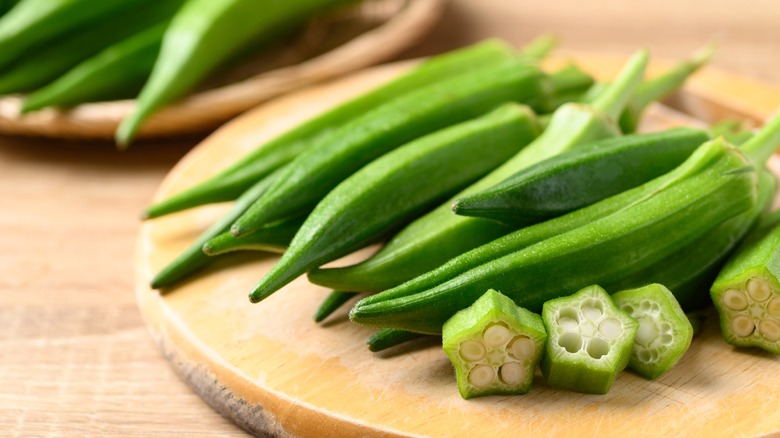For The Best Fried Okra Stop Slicing It In Circles And Do This Instead
Whether it's the slimy inside or the bitter aftertaste, some people would rather not see fried okra on their plate. Yet, fans of the dish think it's an underrated Southern gem. And one of those fans, chef Greg Garrison, claims the way in which the veg is prepped makes all the difference regarding the outcome. Whereas many folks cut okra in bite-sized circular slices, the executive chef and partner at Repeal 33, in Savannah, Georgia (one of the states that produce oodles of okra), says that cutting the vegetable along its length allows the moist center to dry out more, creating a more appealing bite.
"When you cut okra into strips, you're showing off more of the skin and less of that gooey interior," Garrison says. While most people want to prevent slimy pickled okra, one could argue that the texture is even more important when frying it — and "gooey" is not what you're looking for. "Rings tend to protect the center from the drying-out effect and can get soggy pretty quickly," Garrison notes. "Strips just fry up drier and crunchier. You end up exposing more of the inside to kind of flash dry it when it cooks."
However, slicing the veg into strips won't eliminate the viscous texture completely. Garrison says, "You're not getting rid of it — that's just okra being okra — but strips keep it tucked inside instead of spilling out like it does with rings." And that's not the only advantage to slicing the okra into strips, versus circles.
The crispy details behind perfect okra fries
Slicing okra into strips isn't just about reducing the amount of sliminess in the veg. Greg Garrison notes that you also get more batter on every piece, resulting in the best overall texture. "More surface area means more spots for your flour or cornmeal to stick," he says. "More coating, more crust, more crunch."
Before slicing the okra into strips, Garrison suggests dividing the vegetable into sections to help you achieve similarly-sized pieces (along with using the correct grip on your knife). "I take the caps off, then split each pod lengthwise into quarters or thirds," he explains. Unless you have enough time on your hands to fry each strip separately, creating uniform slices is the best way to ensure each piece receives just enough time in the oil. "Keeping them even means they cook consistently, and you get that crisp-outside, tender-inside bite," Garrison says. "Basically, little okra fries."
Of course, as with anything fried, the type of batter used to coat your okra fries makes a big difference in the flavor and texture. Garrison clues us into how he does it in a professional setting. "At Repeal 33, we run a classic dredge: flour first, then buttermilk, then a 50/50 mix of flour and cornmeal with garlic, onion, and smoked paprika," he says. "Cornmeal gives that gritty crunch people love." It's also essential to give your fried okra the finishing touch after mastering the details. "The real trick is keeping the okra dry, seasoning every layer, and frying hot," Garrison notes. "And of course, liberally salting them after they fry."

